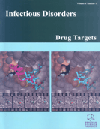-
oa Editorial [Hot topic:Promising Drug Targets in the Identification of Novel Antimalarials (Guest Editor: Norman C. Waters)]
- Source: Infectious Disorders - Drug Targets (Formerly Current Drug Targets - Infectious Disorders), Volume 10, Issue 3, Jun 2010, p. 132 - 133
-
- 01 Jun 2010
- Previous Article
- Table of Contents
- Next Article
Abstract
Malaria is a devastating disease that kills approximately two million people annually. The causative agent of malaria is a protozoan parasite from the genus Plasmodium. Of the species that infect man, Plasmodium falciparum is responsible for the majority of mortalities. Many efforts have been initiated to eliminate or reduce the malaria burden however in the absence of an effective vaccine; drugs must be used for prophylaxis and treatment. Unfortunately P. falciparum has developed resistance to multiple antimalarial drugs and it is envisioned that resistance will continue and undermine the effectiveness of all currently used antimalarials. Drug combination therapies are currently advocated and deployed to slow the development of drug resistance. These combination therapies utilize antimalarial drugs that have been prescribed for decades and therefore the parasites have developed resistance to them when used as monotherapy. Whilst drug combinations using standard antimalarials might slow the development of drug resistance, such combinations only delay the inevitable. The development of novel chemical entities as antimalarial drugs is urgently needed. In this special journal issue, several plasmodial enzymes are discussed as potential antimalarial drug targets. The biological significance of these enzymes is presented with emphasis on target validation, inhibitor design, and antimalarial potential. These enzymes were selected as they are newly characterized targets that have the potential to identify novel chemotypes that can be fed into the antimalarial drug development pipeline. The first set of articles describes enzymes involved in cell cycle control and signalling pathways that directly regulate growth and differentiation of the malarial parasite. The first article by D. Jirage et al. describes the various protein kinases that have been identified and characterized from P. falciparum. The article is followed by E. Pesce et al. that reviews the current understanding of heat shock proteins (HSPs) in the malaria parasite. HSPs play a major role in maintaining cellular homeostasis by regulating signalling pathways, protein folding, assembly and destruction of protein complexes and therefore are attractive drug targets. Regulation of protein function is continued with an article by D-W Chung and K. Le Roch in which they describe the ubiquitin proteasome system (UPS). Although little is known about malarial UPS, conservation of this system and its importance in multiple cellular processes, make it a potential drug target. Finally the theme of cell cycle and signalling is concluded with a review by S. Kozlov et al. which compares and contrasts cellular growth pathways and cell cycle checkpoints between Plasmodium and mammalian cells. Many of the signalling components involved in cell cycle arrest are conserved in Plasmodium, however it is unclear if plasmodial cell cycle checkpoints exist. The second series of articles focus on drug targets directly involved with metabolism of the malaria parasite. An article by T. Donaldson and K. Kim describes efforts to target the purine salvage pathway with particular emphasis on purine nucleoside phosphorylase (PNP). Since the malaria parasite cannot synthesize purines de novo, efforts to target PNP is supported and has resulted in solving the structure and identifying potent inhibitors with antimalarial activity. This is followed by an article which describes the essentiality of panthothenate for parasite growth. Here C. Spry et al. discuss the uptake and metabolism of pantothenate and emphasize its importance in Coenzyme A (CoA) biosynthesis. The article demonstrates that transporters as well as biosynthetic enzymes can be drug targets for the development of novel antimalarials. Aminopeptidases play an essential role during the final stages of hemoglobin digestion to provide free amino acids to the parasite. K. Trenholme et al. review the biology and drug discovery efforts aimed at targeting the eight P. falciparum aminopeptidases. Efforts to characterize the aminopeptidases are a good example of how biological research and inhibitor design can simultaneously be pursued to support antimalarial drug discovery. Finally, an article by M. Phillips and P. Rathod reviews drug discovery efforts targeting the fourth enzyme, dihydroorotate dehydrogenase (DHODH), of the essential pyrimidine biosynthesis pathway. Lead optimization of select DHODH inhibitors has resulted in the identification of potent antimalarial compounds with favourable pharmacological parameters.


